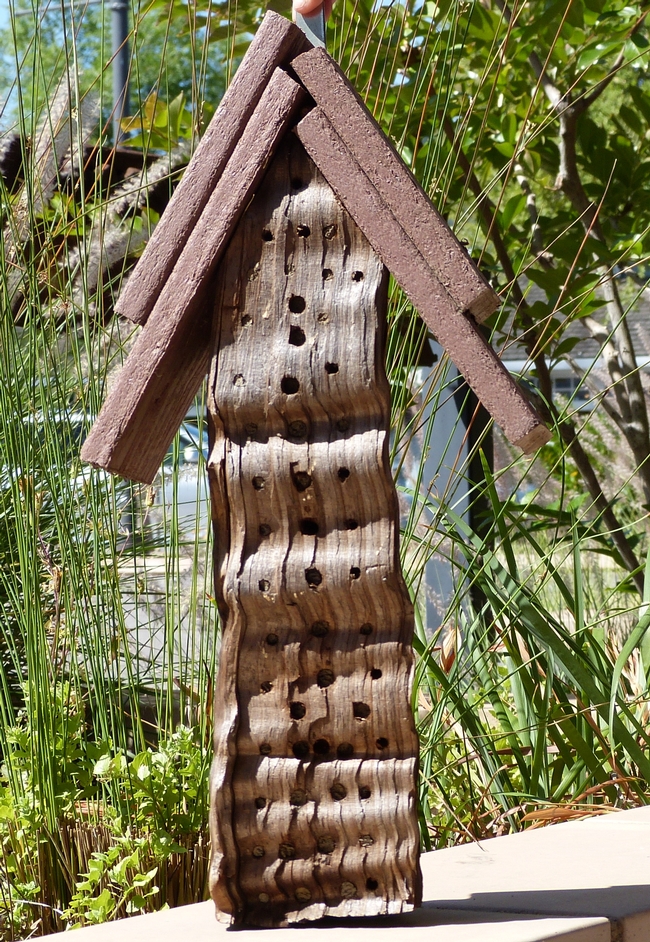The European honey bee came to North America with the first settlers. These bees are native to Europe and Turkey. Currently they are suffering from a disease called “colony collapse,” which causes whole hives to die off.
Scientists are still studying this phenomenon. However, long before the settlers arrived, our native bees, known as solitary bees, were fertilizing native plants.
These bees and plants evolved together. The bees do not produce honey, so they have not been domesticated. But they still visit our gardens and, with some help, they can work for us.
In an effort to help solitary bees, I leave areas of my garden bare, with no mulch or other covering. Nor do I turn this soil. The area is full of holes. Many solitary bees and bumblebees use the ground for nests. Most of them nest alone, providing food and a safe nest for the next generation.
Bumblebees are a little different. They also nest in the ground but usually with a queen. On one occasion, I was able to watch a bee making her nest. She drilled into the soil and kept flying back and forth with nectar or insects. Then one morning the nest disappeared. She had covered it up and let nature take its course until the following spring.
About the same time I heard about nesting blocks of wood for the mason bees that also pollinate our gardens. I had several 4 x 6 pieces. I had them cut to about 12 inches and drilled holes in them. I put them on hangers and left them near fruit trees and blooming flowers.
Some bees did make nests in these holes. They put food for their eggs into the cells. The food varies with the species: some use insects, some use cut leaves and others pollen. They then lay their eggs and put more food between each egg. When the eggs hatch, there is food for them immediately. Once they mature, they emerge from the cell as new bees that will then pollinate this year's crops. They seem to emerge when the fruit trees bloom, typically in March or April.
In my wood pile, I found an interesting piece of wood that I took out and saved. The holes drilled into this piece are of varying size—some 3/8 inch, some 5/8 inch. I had a small roof attached just for aesthetics and it is now attached to my garden fence. This spring I saw a beautiful small bee making a nest in one of the holes. Each hole is sealed with mud. When I counted just a few days ago, there were 52 cells, 39 of them are sealed with mud. This is the best usage I have ever seen.
I have many varieties of flowers for these bees, including lavender and salvia. Bumblebees love both. Not long ago I saw a bumblebee so covered in pollen he could hardly take off. Eventually he made it home.
Paper wasps have lived here many years. I leave them alone because they collect insects for their paper cells and help control bad bugs. They probably get some good ones, too, but that is nature. A few summers ago, I was watching a paper wasp nest on my front porch and decided that the six bees sitting there were done with it and maybe I should remove it. Just then, a much larger wasp flew in and fed each of the other wasps, just as birds do with their young. I was so impressed that I did not touch that nest.
You, too, can help our native bees and wasps. Plant lots of blooming plants, avoid using pesticides in your yard, and leave some soil uncovered. Be aware that all the creatures that fly by your nose are not harmful. Be curious, watch nature and follow her lead.
If you are interested in learning more about native bees, take a look at Field Guide to the Common Bees of California by Gretchen LeBuhn and Noel Badges. Websites can also provide lots of information on building mason bee nests.
Workshop: Napa County Master Gardeners will conduct a workshop on “Cool Season Veggies” on Sunday, August 17, from 2 p.m. to 4 p.m., at the Yountville Community Center, 6516 Washington Street, Yountville. Napa County Master Gardeners will conduct a workshop on “Cool Season Veggies” on Saturday, August 23, at U.C. Cooperative Extension, 1710 Soscol, Napa. Grow your own vegetables even when days are short and nights are cold. Learn which vegetables thrive in cooler temperatures, how to protect them from heat when they are getting started, and how to time planting to ensure months of harvest. To register for the Napa workshop: Online registration (credit card only) Mail in registration (cash or check only).
Master Gardeners are volunteers who help the University of California reach the gardening public with home gardening information. Napa County Master Gardeners ( http://ucanr.org/ucmgnapa/) are available to answer gardening questions in person or by phone, Monday, Wednesday and Friday, 9 a.m. to Noon, at the U. C. Cooperative Extension office, 1710 Soscol Avenue, Suite 4, Napa, 707-253-4143, or from outside City of Napa toll-free at 877-279-3065. Or e-mail your garden questions by following the guidelines on our web site. Click on Napa, then on Have Garden Questions? Find us on Facebook under UC Master Gardeners of Napa County.
Napa County Master Gardeners welcome the public to visit their demonstration garden at Connolly Ranch on Thursdays, from 10:00 a.m. until noon, except the last Thursday of the month. Connolly Ranch is at 3141 Browns Valley Road at Thompson Avenue in Napa. Enter on Thompson Avenue.
